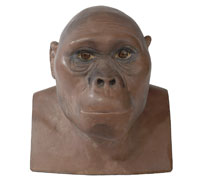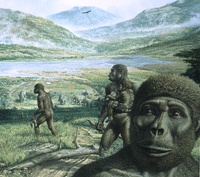Australopithecus africanus

Australopithesis africanus reconstruction
Australopithecus africanus lived between about 3.0 and 2.1 million years ago in southern Africa and had a combination of human and ape-like features.
This species, the first in the Australopithecus group to be named, led to the widespread recognition that our early relatives stood upright long before they evolved larger brains.
Fossil evidence

An illustration of Australopithecus africanus in the African Rift Valley. © John Sibbick / Natural History Museum
The first A. africanus fossil, the skull of a child found at Taung in South Africa, was discovered in 1924. It was studied by a professor of anatomy, Raymond Dart, who named the species and claimed that Australopithecus was a close relative of humans. Dart’s claims were met with skepticism at the time, but he has since been proven largely correct.
Hundreds of fossils of A. africanus have since been found. These early hominins show human features in their jaws and teeth, with smaller front teeth and canines than apes.
Hip and leg bones show that they were small-bodied but regularly walked upright. However, their brain was only ape-sized and in overall body shape they were more ape-like, with relatively long arms and short legs.
Ape-like lifestyle
Although A. africanus regularly walked on 2 legs, limb, hand and foot bones indicate they were also adapted to climbing. It seems likely that these creatures were mainly vegetarian, and that they were not active hunters.
Troop structures, patterns of growth and lifestyle were probably much more like those of apes than humans. And no evidence of an ability to make tools or fire has been found so far.
Their place in the human family tree
Dart believed that A. africanus might represent the ancestor of the first humans (genus Homo). This remains uncertain, although many experts doubt that the australopithecine group is just a side-branch in the human evolution story.
In 2008, the most human-like australopithecine yet discovered, Australopithecus sediba, was unearthed in South Africa. Research suggests this may be a transitional species, providing a snapshot of the evolution of Australopithecus to Homo in action.